A Quick Takeaway
The Story Behind the Trend
How to Make It Work for You
The Community View
Yoga offers strength athletes a powerful, multifaceted edge by systematically addressing common limitations and enhancing key athletic attributes, ultimately leading to superior performance, reduced injury risk, and accelerated recovery. For anyone who lifts weights, whether a powerlifter, bodybuilder, or general strength enthusiast, integrating yoga into a training regimen means unlocking greater range of motion, improving joint stability, and cultivating a deeper mind-muscle connection, making it an indispensable complement to traditional strength training.
The Core Benefits of Yoga for Strength Athletes
Incorporating yoga can dramatically transform a strength athlete’s physical capabilities and longevity in the sport. The benefits extend far beyond mere flexibility, touching on crucial aspects of strength, stability, and mental fortitude.
Improved flexibility and range of motion are perhaps the most obvious advantages. Strength training often leads to tight muscles and restricted movement patterns, which can limit how effectively an athlete can execute lifts like squats or overhead presses. Yoga systematically lengthens muscles and connective tissues, restoring optimal joint mechanics.
Enhanced stability and balance are critical for safely handling heavy loads. Many yoga poses challenge proprioception and require active engagement of stabilizing muscles, particularly in the core, hips, and shoulders. This translates directly to more stable lifting platforms and greater control throughout complex movements.
Injury prevention is a significant factor. By addressing muscle imbalances, improving joint health, and increasing body awareness, yoga helps identify and correct movement dysfunctions before they lead to injury. It strengthens the smaller, often neglected stabilizing muscles that support major joints.
Accelerated recovery is another powerful benefit. Gentle yoga sequences promote blood flow to fatigued muscles, aiding in nutrient delivery and waste removal. The meditative aspects of yoga also help reduce stress hormones, which can hinder recovery and muscle growth.
Finally, yoga cultivates mental focus and body awareness. This heightened connection between mind and muscle allows athletes to better recruit target muscles during lifts, improve technique, and manage the psychological demands of intense training.
Key Yoga Poses for Strength Development
Certain yoga poses are particularly beneficial for strength athletes, targeting areas often tight or weak from heavy lifting. These poses can be integrated into warm-ups, cool-downs, or dedicated yoga sessions.
For Hip Mobility and Lower Body Strength
Poses like Pigeon Pose and Lizard Pose are excellent for opening tight hips, which can restrict squat depth and deadlift mechanics. Low Lunge variations stretch the hip flexors, often shortened from prolonged sitting or heavy leg work.
For active strength and stability, Warrior II strengthens the legs and core while opening the hips. Chair Pose builds isometric strength in the quads and glutes, mimicking positions found in squats.
For Shoulder and Thoracic Spine Mobility
The upper body also benefits greatly. Thread the Needle deeply stretches the shoulders and upper back, improving thoracic rotation crucial for overhead movements. Cat-Cow mobilizes the entire spine, enhancing flexibility and reducing stiffness.
Downward-Facing Dog stretches the hamstrings, calves, and shoulders while decompressing the spine. Poses like Eagle Arms and Cow Face Arms target external and internal rotation of the shoulders, improving range of motion for presses and pulls.
For Core Stability
A strong, stable core is the foundation for all strength movements. Plank and its variations (side plank, forearm plank) are fundamental for building isometric core strength. Boat Pose engages the deep abdominal muscles and hip flexors, crucial for spinal support.
Poses that challenge balance, such as Tree Pose, also indirectly strengthen the core by requiring constant micro-adjustments for stability.
Integrating Yoga into Your Training Regimen
The key to reaping yoga’s benefits is thoughtful integration. Athletes need not abandon their current training but rather weave yoga into their existing schedule.
Aim for 1-3 yoga sessions per week. For those new to yoga, starting with one session is perfectly adequate to begin seeing improvements. Consistency is more important than intensity.
Consider timing your yoga practice post-workout or on active recovery days. A gentle flow after a heavy lifting session can aid recovery, while a dedicated session on an off-day can focus on mobility and deeper stretches.
Explore different yoga styles. Vinyasa or flow yoga can be dynamic and build heat, improving flexibility and cardiovascular health. Yin yoga, with its long-held passive stretches, targets connective tissues and is excellent for deep tissue release and recovery.
Beginners should consider starting with foundational classes like Hatha or restorative yoga. These styles focus on proper alignment and allow time to understand the poses without feeling rushed.
Addressing Common Misconceptions
Many strength athletes harbor misconceptions about yoga that prevent them from exploring its potential. It is important to dispel these myths.
The idea that “yoga is only for flexible people” is a common barrier. In reality, yoga is a tool to build flexibility; you don’t need to be flexible to start. Everyone begins somewhere, and progress is gradual.
Another misconception is that “yoga isn’t a ‘real’ workout.” While some styles are gentle, others, like power yoga or Ashtanga, are incredibly physically demanding, building strength, endurance, and mental resilience.
Finally, some perceive yoga as “too ‘spiritual’ or mystical.” While yoga has spiritual roots, its physical practice, known as Hatha yoga, can be approached purely from a fitness perspective, focusing on the tangible physical and mental benefits without engaging in any specific spiritual doctrines.
A Powerful Edge for Longevity
For strength athletes looking to maximize performance, prevent injuries, and extend their athletic careers, yoga offers a powerful and proven advantage. By systematically improving flexibility, stability, recovery, and body awareness, yoga complements the demands of heavy lifting, fostering a more resilient, capable, and balanced physique. Embracing yoga is not just about stretching; it is about building a more complete, sustainable, and powerful athlete from the inside out.







